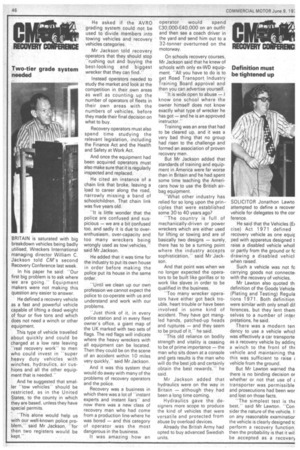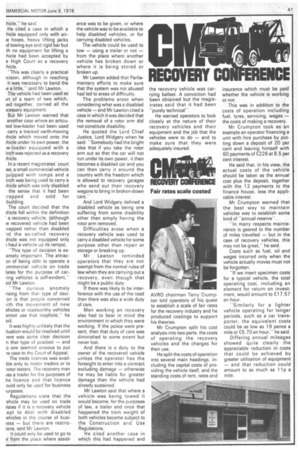Definition must be tightened up
Page 48

Page 49

If you've noticed an error in this article please click here to report it so we can fix it.
SOLICITOR Jonathon Lawto attempted to define a recover vehicle for delegates to the cor ference.
He said that the Vehicles (E) cise) Act 1971 defined recovery vehicle as one equip ped with apparatus designed t raise a disabled vehicle wholl or partly from the ground or le drawing a disabled vehicl when raised.
Such a vehicle was not fo carrying goods not connectei with the recovery of vehicles.
Mr Lawton also quoted th, definition of the Goods Vehicle (Plating and Testing) Regula tions 1971. Both definition were similar with only small dif ferences, but they lent them selves to a number of inter pretations, he said.
There was a modern ten dency to use a vehicle whict was effectively a car transporte as a recovery vehicle by add inc a winch to the front of th( vehicle and maintaining tha this was sufficient to raise i• vehicle from the ground.
But Mr Lawton warned tha there is no binding decision or whether or not that use of z• transporter was permissible and prosecutions had been wor and lost on those facts.
"The simplest test is thE best," said Mr Lawton. "Con. sider the nature of the vehicle. Ii on any reasonable examinatior the vehicle is clearly designed tc perform a recovery function, then the probability is that it wil be accepted as a recovery hide," he said.
He cited a case in which a hide equipped only with airie hoses, heavy lifting jacks id towing eye and rigid bar but th no equipment for lifting a !hide had been accepted by e High Court as a recovery .hicle.
"This was clearly a practical :cision, although in reaching it was necessary to bend the N a little," said Mr Lawton. The vehicle had been used as srt of a team of two which, ;ed together, carried all the .cessary equipment.
But Mr Lawton warned that another case where an articuted low-loader had been used carry a tracked earth-moving :hicle which moved onto the :hicle under its own power, the w-loader equipped with a inch was rejected as a recovery In a recent magistrates' court ise, a small commercial vehicle luipped with ramps and a inch was being used to carry a ?hicle which was only disabled the sense that it had been :rapped and sold for .building.
The court decided that the ;hide fell within the definition a recovery vehicle, (although le recovered vehicle had been ;rapped rather than disabled id the so-called recovery 3hicle was not equipped only ) haul a vehicle up its ramps). "This type of decision is exemely important. The auraean of being able to operate a Drnmercia I vehicle on trade lates for the purpose of carting vehicles is self-evident," id Mr Lawton.
"The curious anomaly rising from that type of decion is that people concerned fith the movement of new elides or roadworthy vehicles annot use that loophole," he aid.
It was highly unlikely that the ituation would be resolved until iere was some clear decision n that type of position — and o one seemed anxious to put ie case to the Court of Appeal.
The trade licences was availble only to motor traders or to iotor testers. The recovery Man as a trader for the purposes of he licence and that licence ould only be used for business iurposes.
Regulations state that the 'ehicle may be used on trade dates if it is a recovery vehicle .ept to deal with disabled Thicles in the course of busiless — but there are restricions, said Mr Lawton.
It could only be used to go to sr from the place where assist wee was to be given, or where the vehicle was to be available to help disabled vehicles, or for carrying disabled vehicles, The vehicle could be used to tow — using a trailer or not — from the place where another vehicle has broken down or where it is being stored or broken up.
Mr Lawton added that Parliamentary efforts to make sure that the system was not abused had led to areas of difficulty.
The problems arose when considering what was a disabled vehicle — and Mr Lawton cited a case in which it was decided that the removal of a rotor arm did not constitute disability.
He quoted the Lord Chief Justice, Lord Widgery when he said: "Somebody had the bright idea that if you take the rotor arm out so that the car will not run under its own power, it then becomes a disabled car and you can then carry it around the country with the freedom which is allowed to recovery garages who send out their recovery wagons to bring in broken-down cars." .
And Lord Widgery defined a disabled vehicle as being one suffering from some disability other than simply having the rotor arm 'removed.
Difficulties arose when a recovery vehicle was used to carry a disabled vehicle for some purpose other than repair or storage or breaking up.
Mr Lawton reminded operators that they are not exempt from the normal rules of law when they are carrying out a recovery, even though that might be a public duty.
If there was likely to be interference with the use of the road then there was also a wide duty of care.
Men working on recovery also had to bear in mind the environment in which they were working. If the police were present, then that duty of care was diminished to some extent but never lost.
And there is a duty to the owner of the recovered vehicle unless the operator has the foresight to enter into a contract excluding damage — otherwise he may be liable for greater damage than the vehicle had already sustained. Mr Lawton said that where a vehicle was being towed it would become, for the purposes of law, a trailer and once that happened the train weight of both vehicles became subject to the Construction and Use Regulations.
He cited another case in which this had happened and the recovery Vehicle was carrying ballast. A conviction had been obtained but the magistrates said that it had been "purely technical".
He warned operators to look closely at the nature of their recovery vehicles and their equipment and the job that the vehicles were to do — and to make sure that they were adequately insured.




















































































































































